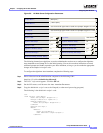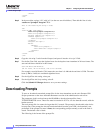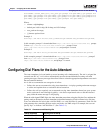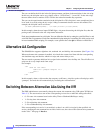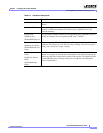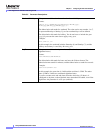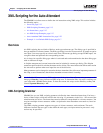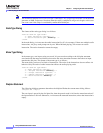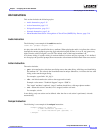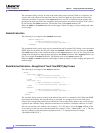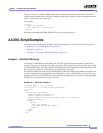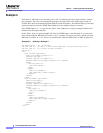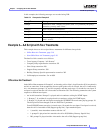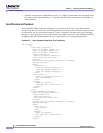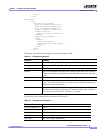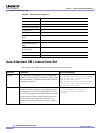
5-15
Linksys SPA9000 Administrator Guide
Document Version 3.01
Chapter 5 Configuring the LVS Auto-Attendant
XML Scripting for the Auto-Attendant
AA Instructions
This section includes the following topics:
• Audio Instruction, page 5-15
• Action Instruction, page 5-15
• Noinput Instruction , page 5-15
• Nomatch Instruction, page 5-16
• Menu Matched Instruction—Recognition of Touch Tone (DMTP) Key Presses, page 5-16
Audio Instruction
The following is an example of the audio instruction:
<audio src= “prompt1” bargein= “T”/>
AA plays the audio file specified in the src attribute. When playing the audio, AA allows the caller to
interrupt the current prompt by pressing digits when the bargein attribute is set to T. AA ignores any
digits from the caller if bargein is set to F. The default value of the bargein attribute is F.
In a <form> dialog, if <audio> dialog is not been defined, AA does not play a prompt. If it is defined,
AA first plays the specified prompt, then executes the action instruction described in the next section.
Action Instruction
The action includes:
• goto—AA transfers the caller from one dialog state to the other dialog. All dialogs are identified by
the attribute “id”. The value in the id attribute must be unique. Otherwise, AA selects the last valid
dialog as the transfer target dialog.
For example, <goto link= “dir_dlg”>
• xfer—AA blind transfers the caller to the target and AA ends.
Example: <xfer name= “Technical Support” target= “5000”/>
The “name” attribute is optional. “target” attribute should be a valid target phone number.
• exit —When this action is reached, AA is stopped, and the call ends.
For example, </exit>
In one dialog, only one action can be defined. After the xfer or exit action is performed, AA ends
automatically.
Noinput Instruction
The following is an example of the noinput instruction:
<noinput timeout=”5” repeat=”T”>
<!—audio instruction (optional) -->
<!-- action instruction pair (optional) -->
</noinput>



